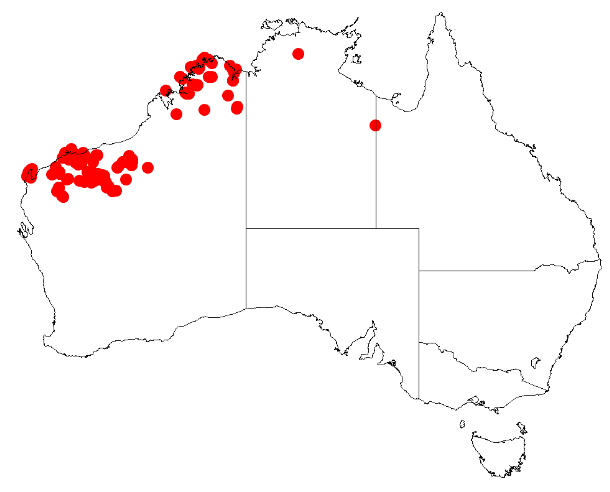Acacia Rigida on:
[Wikipedia]
[Google]
[Amazon]
 ''Acacia rigida'' is a shrub belonging to the genus ''
''Acacia rigida'' is a shrub belonging to the genus ''
 ''Acacia rigida'' is a shrub belonging to the genus ''
''Acacia rigida'' is a shrub belonging to the genus ''Acacia
''Acacia'', commonly known as the wattles or acacias, is a large genus of shrubs and trees in the subfamily Mimosoideae of the pea family Fabaceae. Initially, it comprised a group of plant species native to Africa and Australasia. The genus na ...
'' and the subgenus ''Phyllodineae'' that is native to parts of western Australia
Australia, officially the Commonwealth of Australia, is a Sovereign state, sovereign country comprising the mainland of the Australia (continent), Australian continent, the island of Tasmania, and numerous List of islands of Australia, sma ...
.
Description
The compact or sprawling shrub typically grows to a height of and a width of up to . It has reddish to orange coloured branches with branchlets that are densely covered in fine hairs and setaceous stipules that are in length. 2.5–3.5 mm long. The rigid greenphyllode
Phyllodes are modified petioles or leaf stems, which are leaf-like in appearance and function. In some plants, these become flattened and widened, while the leaf itself becomes reduced or vanishes altogether. Thus the phyllode comes to serve the ...
s have inequilaterally lanceolate to narrowly lanceolate shape that is sometimes linear. The pungent glabrous phyllodes are in length and wide and have five main nerves and a prominent mid-rib. It blooms and produces simple inflorescence
An inflorescence is a group or cluster of flowers arranged on a stem that is composed of a main branch or a complicated arrangement of branches. Morphologically, it is the modified part of the shoot of seed plants where flowers are formed o ...
s that occur singly in the axil
A leaf ( : leaves) is any of the principal appendages of a vascular plant stem, usually borne laterally aboveground and specialized for photosynthesis. Leaves are collectively called foliage, as in "autumn foliage", while the leaves, st ...
s. The spherical flower-heads contain 8 to 12 loosely pack golden flowers. The shallowly curved, red-brown seed pod
This page provides a glossary of plant morphology. Botanists and other biologists who study plant morphology use a number of different terms to classify and identify plant organs and parts that can be observed using no more than a handheld magnify ...
s that form after flowering are to in length and have a diameter of . The pods contain oblong shaped seeds that around in length.
Distribution
It isendemic
Endemism is the state of a species being found in a single defined geographic location, such as an island, state, nation, country or other defined zone; organisms that are indigenous to a place are not endemic to it if they are also found elsew ...
parts of the Wheatbelt region of Western Australia
Western Australia (commonly abbreviated as WA) is a state of Australia occupying the western percent of the land area of Australia excluding external territories. It is bounded by the Indian Ocean to the north and west, the Southern Ocean to th ...
extending from Kellerberrin in the north east around Meckering in the north west to parts of the Darling Range
The Darling Scarp, also referred to as the Darling Range or Darling Ranges, is a low escarpment running north–south to the east of the Swan Coastal Plain and Perth, Western Australia. The escarpment extends generally north of Bindoon, to th ...
to the east of Mundaring in the south west to Cuballing in the south east where it grows in deep sandy soils or gravelly loam or clay soils in scrub or woodland communities.
See also
* List of ''Acacia'' speciesReferences
{{Taxonbar, from=Q42889661 rigida Acacias of Western Australia Plants described in 1999 Taxa named by Bruce Maslin